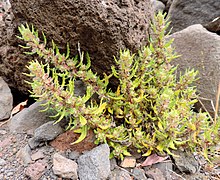Forsskaolea
| Forsskaolea | |
|---|---|

| |
| Forsskaolea angustifolia | |
| Scientific classification | |
| Kingdom: | |
| (unranked): | Angiosperms
|
| (unranked): | |
| (unranked): | |
| Order: | |
| Family: | |
| Genus: | Forsskaolea |
| Species | |
|
See text. | |
| Synonyms | |
Forsskaolea is a small genus of 6 species of perennial herbs in the nettle family with non-stinging hairs and dot-like concretions of mineral matter on their green parts. The genus was named in honor of Swedish botanist Peter Forsskål.[4]
Description[]
- Leaves
- The leaves have three ribs, are alternate, scalloped and with toothlike projections along the edges.
- Flowers
- Budding flowers are flat-topped clusters and bisexual and from the base stem, enclosed in bell shaped, densely hairy, rings of 3-6 bracts. Flowers are minute and unisexual with the female surrounded by a ring of male flowers. Male flowers have 3-5 lobed calyx and the females have none. Solitary stamen, upright wooly ovaries with no style.
- Seeds
- Achenes oval to elliptical, flattened, densely hairy and enveloped in wooly bracts.[2]
Distribution[]
Forsskaolea have found homes in the southern parts of the Palearctic from the Canary Isles and southeast Spain then eastwards to Pakistan and western India.[2]
Selected species[]
- Forsskaolea angustifolia Retz.
- L.f.
- Schinz
- Forsskaolea procridifolia Webb
- Forsskaolea tenacissima L.
- Ehrenb. ex Webb[5]
References[]
- ^ Botanic Garden and Botanical Museum Berlin-Dahlem. "Details for: Forsskaolea". Euro+Med PlantBase. Freie Universität Berlin. Archived from the original on 2012-02-25. Retrieved 2008-04-24.
- ^ a b c Flora of Pakistan. "Forsskaolea Linn". Retrieved 2008-04-24.
- ^ Botanic Garden and Botanical Museum Berlin-Dahlem. "Details for: Forsskalea". Euro+Med PlantBase. Freie Universität Berlin. Archived from the original on 2012-02-25. Retrieved 2008-04-24.
- ^ Gilman, D. C.; Peck, H. T.; Colby, F. M., eds. (1905). . New International Encyclopedia (1st ed.). New York: Dodd, Mead.
- ^ "Forsskaolea L.". African Plants Database. South African National Biodiversity Institute, the Conservatoire et Jardin botaniques de la Ville de Genève and Tela Botanica. Retrieved 2008-04-24.[permanent dead link]
External links[]
- Flora of Israel Online. "Genus Forsskaolea". Hebrew University of Jerusalem. Archived from the original on 2011-10-03. Retrieved 2008-04-24.
- UniProt. "Forsskaolea". Retrieved 2008-04-24.
- Aluka. "Forsskaolea [family URTICACEAE]". African Plants. Ithaka Harbors, Inc. Retrieved 2008-04-24.
Categories:
- Forsskaolea
- Urticaceae
- Urticaceae genera
- Urticaceae stubs